Aquarium plants are tough to care for!
So it’s no wonder many aquarists struggle with their aquarium plants turning yellow and dying.
But your tank plants’ health impacts your betta fish’s health. So, it’s essential to study aquatic plant care!
Aquatic plants turn yellow because of nutrient deficiencies such as iron, phosphate, potassium, or magnesium. Yellow leaves also come from a lack of light or carbon dioxide necessary for photosynthesis. Other tank conditions, like water quality and waste build-up, also affect your plants!
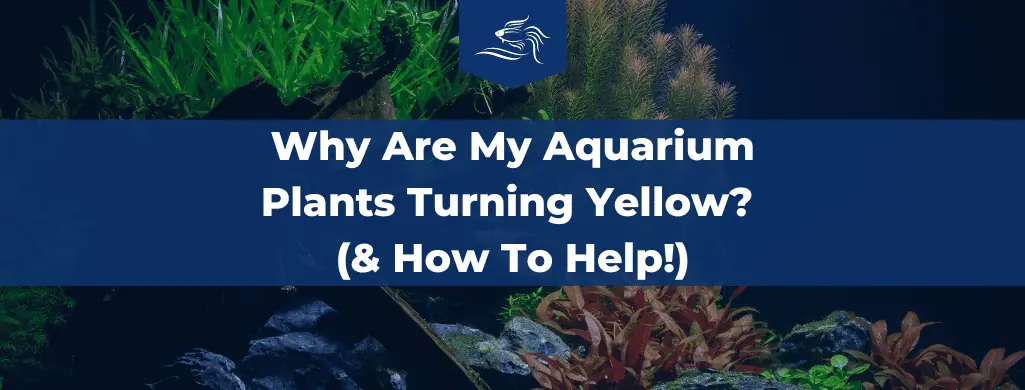
Table of Contents
Why Might Aquatic Plants Turn Yellow?
Plant color changes are one of the easiest ways to tell when there is something off about the tank conditions.
Certain plant species may turn yellow while others go brown.
Some problems impact the entire plant while others would mostly destroy the leaves.
Know the plant species in your tank, and learn as much as possible about care for your plant type.
In the meantime, here are some general causes for yellow or brown plants:
- Nutrient deficiency
- Lack of light
- Carbon dioxide & oxygen deficit
- Water quality/conditions
- Disease (i.e., fungal, bacterial)
- Algae growth
- Age
Nutrient Deficiencies
The list of common nutrients your aquatic plant species need is long. But it isn’t so different from those needed by potted plants or vegetables in the garden.
Most of the time, any fertilizer you use will provide adequate nutrients to your aquarium plants.
Fortunately, many of the critical nutrients your plants need cause unique changes.
This is extremely helpful, as identifying your plant’s specific lack of nutrients will let you fix the problem.
But here are some signs of specific deficiencies:
Iron
An absence of iron causes your plants to grow very pale yellow leaves.
The veins in their leaves are still green, however.
An iron deficiency doesn’t usually impact older leaves on the plant, just any new growth.
Magnesium
Magnesium is important for the chlorophyll in your plants.
So with a lack of magnesium, your plants may begin to turn yellow. Like with iron, the leaf veins will likely remain green.
Remember, an iron deficiency only influences new leaves.
Insufficient magnesium impacts older leaves as well. It sometimes also causes leaves to start wilting at the edges.
Potassium
Without a potassium deficiency, small holes form in the leaf tissue of your plants.
These holes are brown and yellow at the edges, making them easy to spot.
Calcium
Calcium is more important to some plant species than others.
But a calcium deficiency generally causes leaves to grow in strange ways.
You might see green leaves, but they appear all knotted up and twisted. A lack of calcium often causes this.
Aquarium Lighting
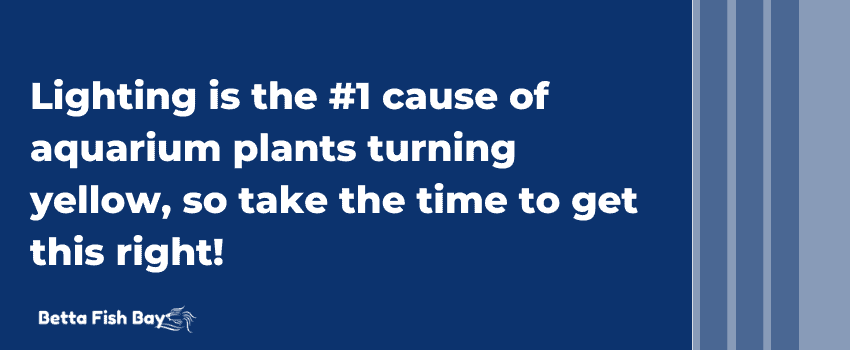
Adequate lighting is one of the most important resources your plants need.
To keep temperatures level, we recommend using artificial lighting to meet those aquarium lighting requirements.
It’s tough to get the lighting exactly right so your plants and betta are happy. We recommend getting an aquarium lighting system with a timer.
Without adequate lighting, your plants cannot perform photosynthesis and feed themselves.
This is where you may see browning or yellowing on the plants in your fish tank.
Conversely, harsh lighting is bad for both the plants and your beautiful aquarium fish.
Carbon Dioxide and Oxygen
When they partake in photosynthesis, your plants produce both food and oxygen. But they need some amount of oxygen to actually do this at all.
After all, a solid supply of carbon dioxide is a crucial ingredient to this process.
This means making sure your plants have a good carbon dioxide intake.
Like the nutrients we discussed, a carbon deficiency in the fish tank causes wilting and discolored leaves.
This is because your plants are struggling to sustain themselves through photosynthesis.
Dissolved oxygen in the tank is also critical to your plant’s survival. But it’s even more critical to any species of freshwater fish in the aquarium.
Water Quality
Just like fish, aquatic plants are sensitive to changes in their environment.
Some of the most common problems in the fish tank are:
- Fish waste build-up
- Ammonia/nitrite/nitrate levels
- pH levels
- Hardness
- Temperature
Waste and Chemical Levels
Waste build-up may look like actual waste, but it’s often caused by uneaten fish food left in the tank for too long.
Even with a solid tank filter and a large aquarium setup, you must consistently clean out uneaten fish food and other waste.
When it is left to accumulate, you see other changes to the water conditions. For example, ammonia spikes may start this way.
Harmful chemicals wear down your plants and may cause the leaf tissue to decay or change color to yellow or brown.
pH, Hardness & Temperature
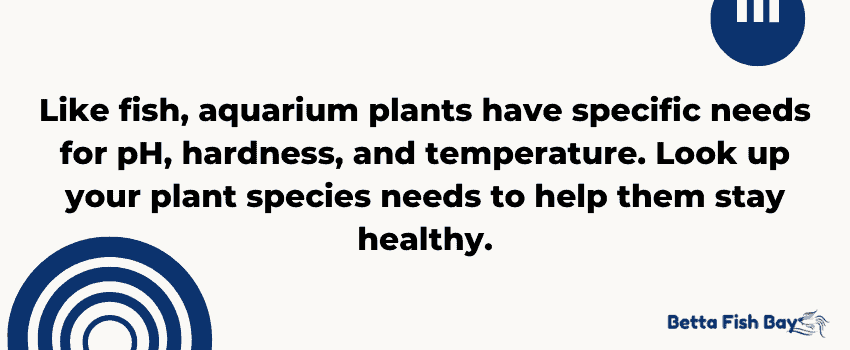
Your fish aren’t the only ones who are picky about their water parameters.
Choose plants you know can thrive in your tank setup without making too many changes.
They won’t survive if you force them into conditions they aren’t suited to.
pH and temperature levels have similar impacts on your plants as they do on your fish.
Plants struggle to grow if it’s too cold and die very quickly if it’s too hot.
They also won’t grow in extremely acidic or basic conditions. Each aquatic plant type has different needs, so select yours carefully.
Water hardness causes very similar problems to those of calcium deficiency.
Gnarled leaves are almost guaranteed if the hardness of your aquarium water is wrong.
All these conditions influence the coloration and strength of your plants. These are the first things to check if your plants (or your fish) start to look a little sad.
Disease
Common fish illnesses just may have an impact on your plants as well.
Namely, bacterial and fungal infections are dangerous to them. If this is the case, you will likely see other signs of disease in your plants.
You might see small holes, eroding leaves, or even rot coming from your plant’s roots upward.
In the event you find yourself with a diseased aquarium plant, get your fish moved to another tank for a while. You need to clean up in case the bacteria is dangerous to fish.
Algae Growth
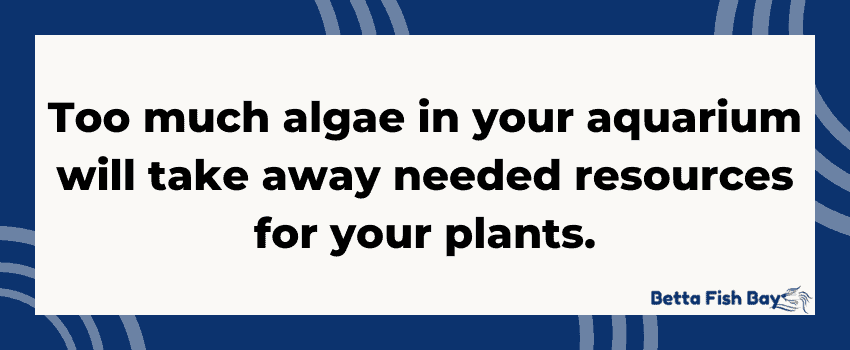
The effect of algae on plants is simple: It takes away resources.
For example, algae growing near the surface of the water takes up a lot of light.
Even lower in the tank, it consumes many of the same nutrients and gases your aquarium plants could use.
When your plants start to droop or go yellow, always do a sweep for algae.
Even if the root of the problem is insufficient light or calcium, removing algae will only help. In fact, it might solve the problem altogether.
If algae is regularly becoming a problem for you, consider getting some aquarium snails to help out.
Age
This is probably an underwhelming answer, but in truth, your plants may just be getting old.
Different aquatic plant species have longer or shorter lifespans. But on average, plants only live from 3-6 months before seeding and dying off.
If you’ve had your plants for a while and notice yellowing or other signs of decay, it’s probably age.
Treating & Preventing Yellow Aquarium Plants
Proper Lighting
Longevity
The trick to setting up your aquarium lighting is to get something highly customizable.
You want to have a light with various brightness settings and a timer.
Leaving the light on at all times is extremely stressful on your fish and won’t do your plants much good either.
Here’s a good light on Amazon.
It has a timer, different color and brightness settings, and fish keepers say it works great for their plants!
The downside is some say it is difficult to use.
Ideally, your plants get at least eight hours of light daily. Fortunately, this is about what your betta needs as well.
When you start a new planted aquarium, provide only six hours of light or fewer. This prevents algae growth from taking over.
Once your plants get bigger, extend their exposure to light!
Intensity
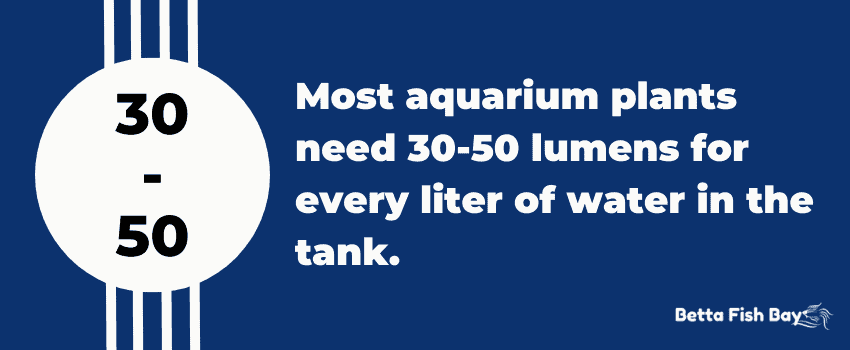
The amount of light you need will depend on the plant species you have. This varies anywhere from 300 lux to more than 5,000 lux.
When you purchase a light, you are likelier to see intensity measured in lumens. Lumens are the technical measurement for a bulb’s light output.
Let’s do a little bit of math real quick:
Most aquarium plants need something between 30-50 lumens for every liter of water.
As there are about four liters in one gallon, a five-gallon tank would need a light with an output somewhere around 750 lumens.
The light linked above provides up to 820 lumens, which means it works great for a tank of this size.
Remember, though, the exact lighting needs differ from plant to plant.
Regular Water Changes and Filtration
Keeping up with water changes is one of the most important things you will ever do for your plants and fish.
For a betta, you need to perform water changes of about 25% weekly.
If you need more information on the best practices for this, read our article on how often and how much water to change in your betta’s tank.
You also need to keep a good filter in the tank. Betta fish prefer a very gentle current, like a sponge filter.
But you need to ensure plenty of oxygen in the tank as well, so get an aerator separately if needed.
One way to help reduce waste build-up and make cleaning easier is to remove uneaten fish food as soon as your betta is done eating.
We also recommend you an aquarium gravel vacuum. Using a gravel vacuum prevents sudden changes in the aquatic environment.
You would be surprised how much gets trapped in the aquarium substrate, especially if you have snails or shrimp.
Fertilizer
General
Using a general fertilizer is a good idea to promote healthy growth in your aquatic plants.
As you gain more experience, you might move on to a different fertilizer. But we have two suggestions you might start out with.
The first is Flourish fertilizer, which is highly recommended by freshwater fish keepers. It’s a tried and true fertilizer, so it’s a great starting point for beginners.
We also like this API fertilizer on Amazon. This is another trusted brand we know to get results.
Always read the instructions on these products very carefully and use them exactly as recommended.
Targeted Fertilizers
The above products are great for generally helping with healthy plant growth. But sometimes, your plant needs a boost of something specific.
There are unique fertilizers for your plants as iron or calcium supplements, for example.
Sometimes it’s as simple as changing from one general fertilizer to another. Each of these products prioritizes something different in their formulas.
The API product above, for example, boasts high iron and potassium content.
CO2 Injections
We know CO2 is critical to healthy aquarium plants.
But using liquid carbon in the tank does absolute wonders for wilting plants.
Here’s an API carbon product we recommend. It’s easy to use, but you need to read the instructions carefully.
Follow dosing exactly, and keep an eye on pH levels in the tank. If used correctly, this product won’t change pH.
Disease Prevention
Disease prevention starts when you purchase your plants and pets. Make sure the seller is trustworthy.
Inevitably, aquarists sometimes end up with unwanted snails or parasites on their plants.
From there, you must protect plants from sick fish and vice versa. Use a quarantine tank for your betta if necessary.
There are also treatments to use in the tank to kill off bacteria. But which one you use is dependent on what the disease is.
The easiest way you will prevent diseases from spreading through your tank is to keep it clean.
Maintain water quality by performing weekly water changes, and be sure to test the water regularly.
Compatibility with Betta Fish
At the end of the day, your plants will only survive if their needs are met on the most basic level.
In a freshwater aquarium where your betta lives, the plants must be able to live in high temperatures and with no to very low ammonia and nitrate content.
Research your plants closely before buying, and get them from a trusted source.
For a closer look at the tank conditions your betta requires, take a look at our article on water parameters.
Keep It Clean (There Are Fish in the Room)
Aquatic plants turn yellow and wilt for various reasons, from parasites to an iron deficiency to a build-up of fish waste in the tank.
The best ways to target these problems are to use good fertilizer and supplements, keep the tank water clean and parameters solid, and provide good lighting.
These resources are more than enough to help your plants thrive, which also helps your betta.


